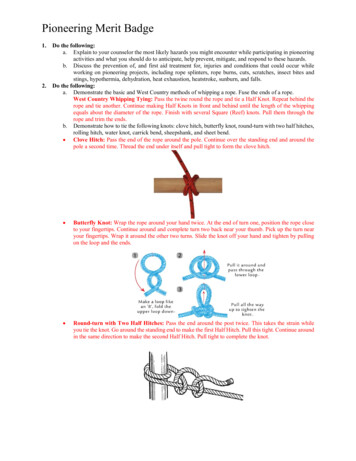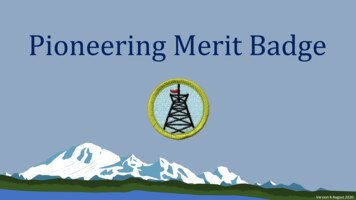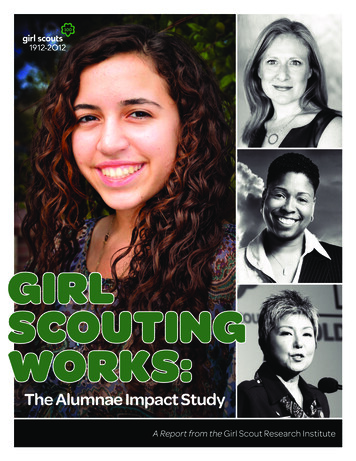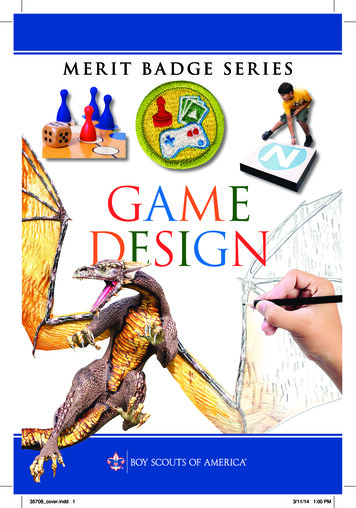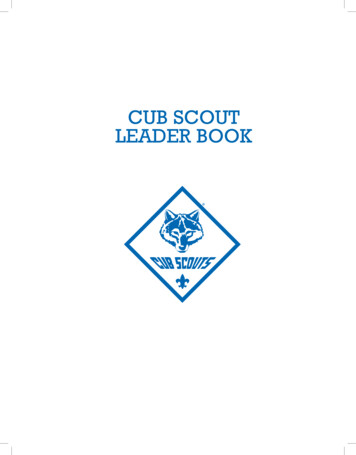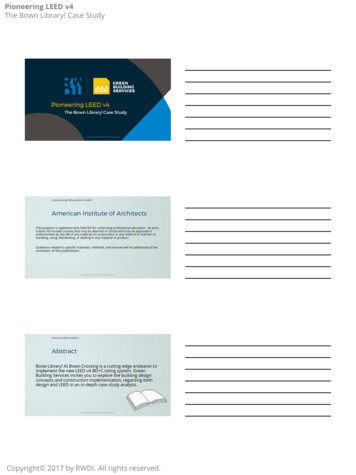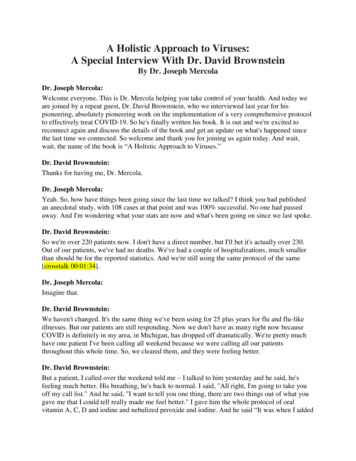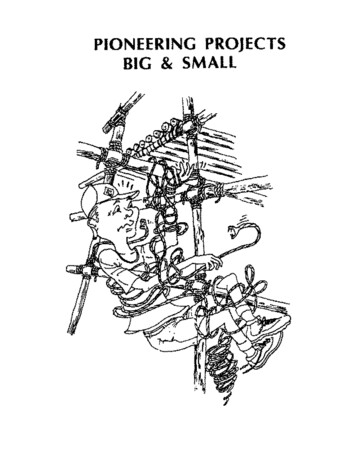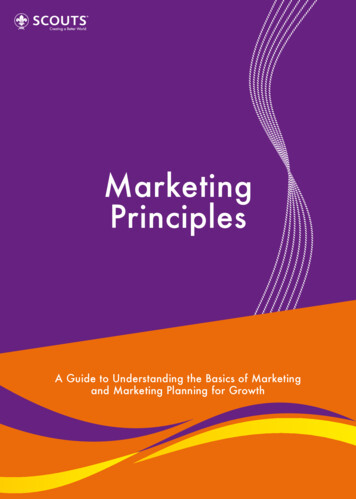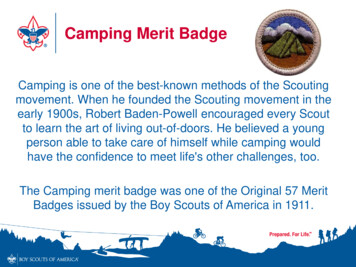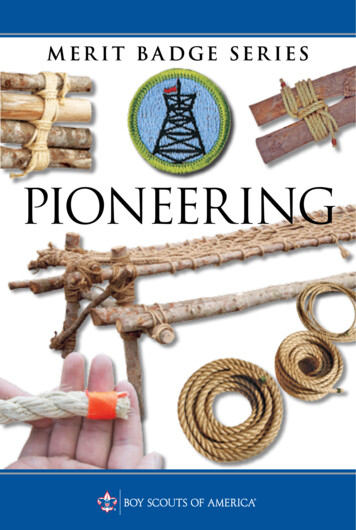
Transcription
PIONEERING
BOY SCOUTS OF AMERICAMERIT BADGE SERIESPIONEERING“Enhancing our youths’ competitive edge through merit badges”
Section 0.Requirements1. Do the following:a. Explain to your counselor the most likely hazards youmight encounter while participating in pioneering activities and what you should do to anticipate, help prevent,mitigate, and respond to these hazards.b. Discuss the prevention of, and first-aid treatment for,injuries and conditions that could occur while workingon pioneering projects, including rope splinters, ropeburns, cuts, scratches, insect bites and stings, hypothermia, dehydration, heat exhaustion, heatstroke, sunburn,and falls.2. Do the following:a. Demonstrate the basic and West Country methods ofwhipping a rope. Fuse the ends of a rope.b. Demonstrate how to tie the following knots: clovehitch, butterfly knot, roundturn with two half hitches,rolling hitch, water knot, carrick bend, sheepshank,and sheet bend.c. Demonstrate and explain when to use the followinglashings: square, diagonal, round, shear, tripod, andfloor lashing.3. Explain why it is useful to be able to throw a rope, thendemonstrate how to coil and throw a 40-foot length of¼- or 3/8-inch rope. Explain how to improve your throwingdistance by adding weight to the end of your rope.4. Explain the differences between synthetic ropes and naturalfiber ropes. Discuss which types of rope are suitable forpioneering work and why. Include the following in yourdiscussion: breaking strength, safe working loads, and thecare and storage of rope.4PIONEERING
.Section 05. Explain the uses for the back splice, eye splice, and shortsplice. Using ¼- or 3/8-inch three-stranded rope, demonstrate how to form each splice.6. Using a rope-making device or machine, make a rope atleast 6 feet long consisting of three strands, each havingthree yarns. Whip the ends.7. Explain the importance of effectively anchoring a pioneering project. Describe to your counselor the 1-1-1 anchoringsystem and the log-and-stake anchoring methods.8. With the approval of your counselor, demonstrate and usea rope tackle. Be sure the rope tackle is secured properly.Explain the advantages and limitations of using a ropetackle. Describe the potential damage that friction can doto a rope.All pioneering projects constructed for this merit badgemust comply with height standards as outlined in theGuide to Safe Scouting.9. By yourself, build a trestle using square and diagonallashings. Explain why trestles are used when constructingpioneering projects.10. With the approval of your counselor and using appropriatelashings and pioneering techniques, build and use one fullsize pioneering project from either group A or group B.Your project must comply with the requirements of theGuide to Safe Scouting.Group A: Tower OR bridgeAnchor your project as appropriate and necessary. Explainhow your anchoring system works. Group A projects maybe worked on in a group and with others.Group B: Camp chair OR camp tableGroup B projects must be worked on individually.PIONEERING5
.PIONEERING RESOURCESPioneering ResourcesScouting LiteratureBoy Scout Handbook; Guide to SafeScouting; Deck of First Aid; EmergencyFirst Aid pocket guide; Basic IllustratedWilderness First Aid; Be Prepared FirstAid Book; Basic Illustrated OutdoorKnots; Deck of Knots; Knots and How toTie Them; Camping, Climbing, First Aid,Model Design and Building, Textile, andWoodwork merit badge pamphletsVisit the Boy Scouts of America’sofficial retail website (withyour parent’s permission) athttp://www.scoutstuff.org fora complete listing of all meritbadge pamphlets and otherhelpful Scouting materialsand supplies.BooksAshley, Clifford W. The Ashley Book ofKnots. Doubleday, 1976.Budworth, Geoffrey. The UltimateEncyclopedia of Knots and Ropework.Southwater, 2010.Jarman, Colin. The Knot Tying Bible:Climbing, Camping, Sailing, Fishing,Everyday. Firefly Books, 2013.Pawson, Des. Handbook of Knots.DK Publishing, 2004.Pawson, Des. Knot Craft: 35 RopeworkProjects. Paradise Cay, 2011.Pawson, Des. Knots: The CompleteVisual Guide. DK, 2012.Penn, Randy. The Handy Box ofKnots: Useful Knots for EverySituation, Indoors and Out.Sterling Innovation, 2008.Perry, Gordon. Knots. WhitecapBooks, 2006.Perry, Gordon. Knots: A PracticalStep-by-Step Guide to Tying Over100 Knots. Metro Books, 2002.Bigon, Mario, and Guido Regazzoni.The Morrow Guide to Knots. WilliamMorrow, 1988.Salvadori, Mario. The Art ofConstruction: Projects and Principlesfor Beginning Engineers & Architects.Chicago Review Press, 2000.Budworth, Geoffrey. The Ultimate Bookof Everyday Knots. SkyhorsePublishing, 2012.Sweet, John. Scout Pioneering. ScoutAssociation, 1974.Toghill, Jeff. Knots & Splices. SheridanHouse, 1998.PIONEERING95
PIONEERING RESOURCES.Toss, Brion. The Complete Rigger'sApprentice: Tools and Techniques forModern and Traditional Rigging.International Marine/RaggedMountain Press, 2016.The Boy Scouts of America isalso grateful to the men and womenserving on the Merit Badge MaintenanceTask Force for the improvements andupdates to this pamphlet.Online ResourcesPhoto and Illustration CreditsFirst Aid merit badge pamphlet,http://boyslife.org/merit-badges/first aid-merit-badge/Larry Green, courtesy—pages 57, 65, 73,76, 77, 78, 82 (3-2-1 anchor), and 84Guide to Safe Scouting, knowledgmentsThe Boy Scouts of America thanks LarryGreen and Dr. James Roberts for theirassistance in updating this pamphlet.We are grateful to pioneering legendAdolph Peschke, West Des Moines,Iowa, for writing the 1993 edition ofthe Pioneering merit badge pamphlet.Mr. Peschke’s son, Donald Peschke,also was instrumental in developing the1993 edition. Many of the techniquesshown in that edition have beenadapted for subsequent printings.Over the years, many Scouters andpioneering experts have assisted withrevising the merit badge requirements,pamphlet text, and illustrations, andwe are grateful for their input.Among these individuals have beenKen Hammond, Richard Jahn, MikeKleckner, Ken Knowles, R. G. Kruger,Brian Nulle, Paul Oliphant, ClarenceOlson, Bill Schrichte, Dan and GretchenWalters, and Elaine Waraczynski.96PIONEERINGShutterstock.com, courtesy—pages15 ( wacpan), 17 ( Iokvi),18 ( magmarcz), 19 (manila, Hellen Sergeyeva; sisal, IrinaSokolovskaya; cotton, Stock image;coir, chinahbzyg); 21 ( Sementer),and 28 ( Mikhail Pashchenko)All other photos and illustrations notmentioned above are the property ofor are protected by the Boy Scoutsof America.Eric Bakke—page 10Dan Bryant—page 11Bruce Levitt—page 94John McDearmon—all illustrations onpages 23–24, 26–27, 29–39, 41–45,47–50, 53–56, 60–64, 66–69, 79–80,85–88, and 90–93Christian Michaels—page 14
the Pioneering merit badge pamphlet. Mr. Peschke's son, Donald Peschke, also was instrumental in developing the 1993 edition. Many of the techniques shown in that edition have been adapted for subsequent printings. Over the years, many Scouters and pioneering experts have assisted with revising the merit badge requirements, pamphlet text, and .
